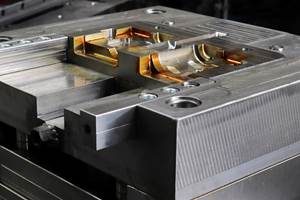FAQs about Lasers and Moldmaking
After doing his own homework on laser engraving mold cavities, a reader reached out to MMT with specific questions about laser types, applications, wattage, work envelope size, cost and safety requirements. We then reached out to industry for some insight.
LaserStar Technologies was the first to respond. This supplier of laser sources and systems for laser welding, laser marking, deep engraving and laser cutting offers answers to a few frequently asked questions about lasers in moldmaking.
There are many uses for laser technology in moldmaking, including wear, damage and design changes due mold modifications or re-manufacturing. Laser welding systems can prevent the need to re-fabricate and focus on repairing rather than re-manufacturing parts.
Laser marking and engraving technology is also a very common practice in this market used to brand, serialize and create markings and deep engravings on tools as well as molds and mold cavities. According to LaserStar, shops currently using laser technology are often amazed at the wide range of applications and the ability to produce a higher quality product in less time with fewer materials while eliminating excessive heat effects.
Q: How is laser engraving used and what type of lasers are used for moldmaking applications?
A: In moldmaking applications, typically a fiber or flash lamp laser marking system is used for either marking insert position, tool ID number, material type and various other information about the mold. Also, lasers are used to create the mold or surface texture. Fiber lasers have been replacing flash lamp lasers for engraving due to their longer life, high pulse-to-pulse stability and low maintenance.
Q: What type of laser is used for deep engraving?
A: Deep engravings are typically of depths greater than 0.001 of an inch. Fiber lasers are ideal for deep engraving as they are efficient and fast.
Q: What type of laser is used for shallow engraving?
A: Shallow engraving or surface markings are either anneal markings (heating of the surface) or light ablation with minimal surface removal measured in microns. CO2, ultraviolet, fiber, and flash lamp lasers can achieve shallow or surface markings.
Q: Can you provide guidelines for laser wattage, typical work envelope sizes, cost range and safety requirements?
A: The wattage will be determined by the application, cycle time and budget. Typical wattages are 20-, 30-, 50- and 100-watt. The work envelope again is determined by the application. The use of safety glasses during operation is recommended with Class 4 (open) laser marking systems, and Class 1 systems come with enclosures to safeguard operators from associated laser hazards.
Q: What are some important considerations when comparing lasers?
A: For the mold industry, the fiber laser marking system would be the preferable laser since it reacts the best on metal directly. Also, in the mold industry they are looking for deep engravings (typically .005” to .010”). Fiber lasers require minimal maintenance as they are fully air-cooled, and minimal optics are involved. Fiber lasers are typically rated at 50,000+ hours of useful work life. There is less calibration and adjustments needed in a fiber compared to a flash lamp system as the diodes do not degrade as flash lamps do over time of use. In addition, flash lamp systems need to have water changes, optics cleaned and/or replaced and aligned. The fiber lasers have minimal consumables like air filters and protective lens for the output lens. This means that fiber laser marking systems are much less expensive to operate.
When comparing laser systems, you should also consider the software package that will be used with the system. Some laser marking systems come with different software packages from basic engraving to 2D/3D complex layered engravings for creating custom textures and three dimensional surfaces.
Related Content
Surface Finish: Understanding Mold Surface Lingo
The correlation between the units of measure used to define mold surfaces is a commonly raised question. This article will lay these units of measure side by side in a conversion format so that companies can confidently understand with what they are dealing.
Read MoreHow to Use Diffusion Bonding to Optimize a Mold’s Thermal Performance
Joining dissimilar metals has tremendous potential for conformal cooling, but to successfully use diffusion bonding, a mold builder must understand the complexities of the interface and its effect on the chemical and thermo-mechanical properties of the bond.
Read MoreQuestions and Considerations Before Sending Your Mold Out for Service
Communication is essential for proper polishing, hot runner manifold cleaning, mold repair, laser engraving and laser welding services.
Read MorePredictive Manufacturing Moves Mold Builder into Advanced Medical Component Manufacturing
From a hot rod hobby, medical molds and shop performance to technology extremes, key relationships and a growth strategy, it’s obvious details matter at Eden Tool.
Read MoreRead Next
Reasons to Use Fiber Lasers for Mold Cleaning
Fiber lasers offer a simplicity, speed, control and portability, minimizing mold cleaning risks.
Read MoreHow to Use Strategic Planning Tools, Data to Manage the Human Side of Business
Q&A with Marion Wells, MMT EAB member and founder of Human Asset Management.
Read MoreHow to Use Continuing Education to Remain Competitive in Moldmaking
Continued training helps moldmakers make tooling decisions and properly use the latest cutting tool to efficiently machine high-quality molds.
Read More










.jpg;maxWidth=300;quality=90)






_300x250 4.png;maxWidth=300;quality=90)








